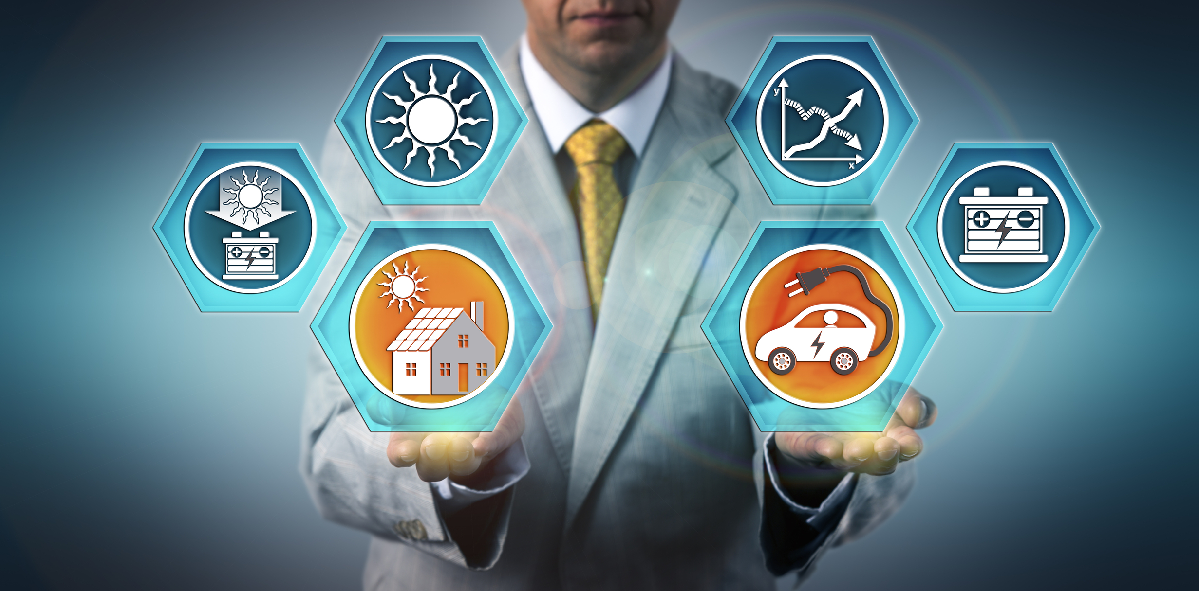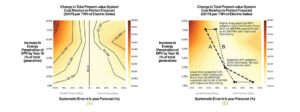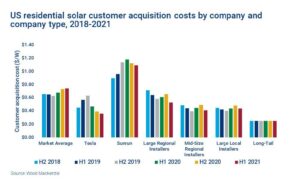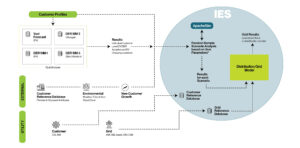
Inaccurate DER and electrification growth forecasts can have significant impacts on capital and operating costs as well as on the ROI in DER growth.
Numerous entities are engaged with the distributed energy resources (DER) and electrification markets, primarily driven by sustainability, decarbonization and efficiency efforts. However, achieving an optimal return on investment (ROI) is still a key goal. This goal can be achieved only with highly accurate data and analyses of individual customers. Inaccurate DER and electrification growth forecasts can have significant impacts on capital and operating costs as well as on the ROI in DER growth. Figure 1 depicts (A) the change in total present‑value system cost relative to a perfect forecast and (B) the change in that cost with improved forecast accuracy.
(Source: Estimating the Value of Improved Distributed Photovoltaic Adoption Forecasts for Utility Resource Planning, National Renewable Energy Laboratory)
In addition to utilities, marketers and installers of DER and electrification are affected by the cost of acquiring customers. Figure 2 depicts the cost of customer acquisition incurred by installers of solar systems.
(Source: Wood Mackenzie)
In the case of inaccurate forecasts and to address the costs of acquiring new customers, the cost impacts present a significant hinderance to the growth of DER and electrification adoption. These impacts can be alleviated through the use of advanced data, modeling and analytics.
Complexity of Forecasting DER and Electrification Penetration Growth and Impact
Customer adoption of DER and electrification occurs within a complex environment. Understanding how that environment influences the decision-making process is key to producing an accurate forecast of DER and electrification penetration growth and the subsequent impact on the electric system. On the distribution system, this understanding is dependent upon being able to accurately forecast the timing, location, type and usage of all types of DER and electrification, singly and in combination. To achieve this accuracy, three key aspects of individual customers must be understood:
- Their energy usage in terms of their structure and structure systems characteristics, end uses, and activity
- Their structure and situation hinderances and suitability for adoption
- Their DER and electrification adoption decision processes
An Individual Customer’s DER and Electrification Adoption Decision Process
A range of forecasting methods are available, with widely varying levels of detail and accuracy, to forecast DER and electrification adoption. Looking at the problem from a bottom-up perspective, numerous aspects affect a customer’s DER and electrification-adoption decision process. Figure 3 depicts these aspects and how they work together to ultimately determine the likelihood of a specific customer adopting DER or electrification. Understanding each of these aspects and the influence they have is critical to accurately forecast if and when a customer will adopt DER or electrification.
(Source:Guidehouse – Energy, Sustainability and Infrastructure Advanced Solutions)
Levels of Detail of Customer and Adoption Forecast Accuracy
From a strictly data perspective, the level of detail (LOD) concerning the structure of a customer’s building and the building’s internal systems, end uses, occupancy and activity define the extent to which structural and operational aspects of the building can be explicitly identified that would either:
- Need to be dealt with in adopting types of DER or electrification
- Make the building unsuitable for adoption
Additionally, LOD defines the extent to which a digital twin of a customer’s building can be created. A digital twin is a dynamic digital model of a physical asset, process or person. What separates a digital twin from other digital models is that, through the use of real-time data collected from its physical twin, the digital twin can come into complete operational synchronicity with its physical twin. The initial focus of digital twins was on producing simulation-based, predicted operation founded solely on fixed, fundamental engineering-based models of their physical twins. Since then, digital twins have evolved to incorporate various forms of machine learning. This development enables a digital twin to remain in synch with its physical twin as time passes. Integrated Environmental Solutions (IES) has developed a building digital twin model that is capable of accurately modeling the energy usage of any type of building down to the finest LOD. The model supports a wide range of apps that are employed in defined use cases associated with building analysis and management, load prediction, and DER and electrification suitability.
Dynamic Customer DER and Electrification Adoption Decision Models
Guidehouse excels at developing sophisticated customer decision models that establish a customer’s propensity for adoption and then dynamically adjust that propensity over time in response to personal and external drivers. In this case, individual customer decisions concerning the adoption of DER or electrification are modeled by integrating the output of the financial analysis into a dynamic, customer decision-making likelihood model that accounts for the change in a potential customer’s propensity over time (emergent behavior). Guidehouse has developed a range of advanced DER and electrification adoption forecasting models that deliver the required level of accuracy needed to support integrated planning and operations processes. All DER and electrification adoption forecasting methods have pros and cons; the benefit-cost of using any specific method must be carefully assessed with respect to the availability of data and the method’s computing costs.
Advanced DER and Electrification Targeting, Forecasting and Impact Analysis
Guidehouse has developed an alliance with Integrated Environmental Solutions (IES) to establish a comprehensive platform to support the analysis, targeting and forecasting of DER and electrification growth. The heart of this platform is an integrated, digital twin model encompassing both an entire customer base and the transmission and distribution (T&D) grid serving that customer base, coupled with Guidehouse’s customer adoption forecasting models discussed previously for all forms of DER and electrification.
(Source:Guidehouse – Energy, Sustainability and Infrastructure Advanced Solutions)
Additionally, Guidehouse has defined a number of commercial and industrial process-modeling methods and has assessed their pros and cons. The company is constantly evaluating and looking to integrate newly established methodologies. Through its alliance with IES, Guidehouse has the capability to model individual buildings and specific DER and electrification adoption over an entire wide-area and couple the building models with a highly detailed model of the T&D system serving those customers.


















